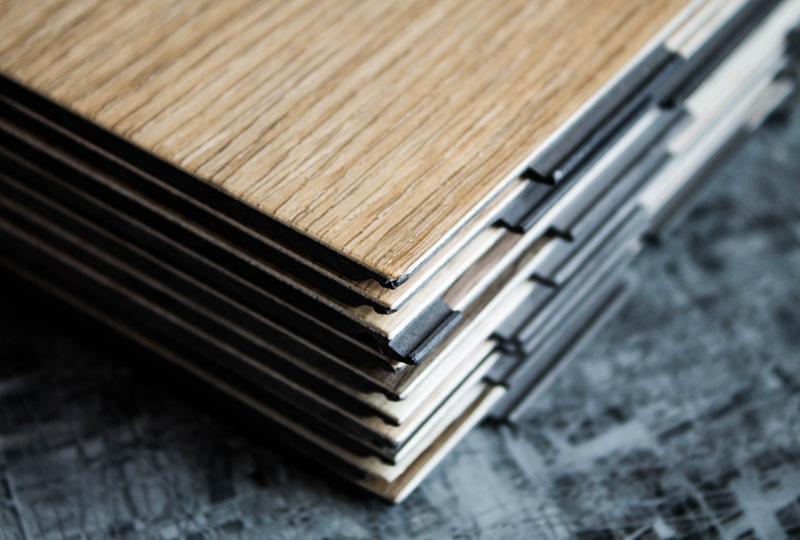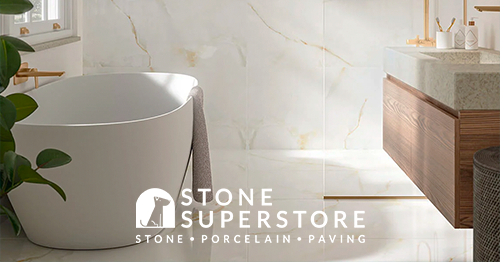If you’re searching for new flooring, you may have heard of LVT – which stands for luxury vinyl tile. As the name suggests, this versatile flooring type is made of vinyl and presents a high-end, realistic look and feel.
A favourite with homeowners as well as commercial businesses, LVT flooring replicates the appearance of natural materials such as wood or stone, making it both stylish and affordable.
What is LVT flooring made from?
LVT is made up of multiple material layers, which together make it strong, stable, durable, stain-resistant, and water-resistant. These layers also protect it against indentations caused by pressure and impact.
The layers that typically comprise LVT flooring include:
1. A protective layer at the very top that prevents the floor from being scratched, stained, or damaged in other ways.
2. Below that is one or two wear and tear layers that maximise the floor’s strength and slip resistance.
3. Then there’s the design layer, which gives the tile its appearance of wood or stone.
4. At the bottom is an acoustic later that minimises surface sound when you walk across it.
5. In some brands of LVT flooring, there may be another layer that provides extra cushioning. If not, a separate underlay will deliver the same effect.

Types of LVT flooring
There are various types of LVT flooring for you to choose from, with each designed to suit your home, lifestyle, and chosen installation method. Some of the most popular LVT flooring types include:
Glue-down LVT
Individual LVT planks or tiles are glued directly to the subfloor using a specific adhesive. Glue-down LVT provides a stable and permanent installation, making it suitable for high-traffic areas, even offices and commercial settings.
Click LVT
Also called floating LVT, click LVT uses a simple locking mechanism that allows the planks or tiles to be clicked together during installation. This type of LVT doesn’t require adhesive, which makes it a popular choice for DIY projects or for renters who are looking for temporary home improvements. It can be installed over various subfloor types, including concrete, wooden floorboards or existing tiles. Click LVT is perfect for living rooms, bedrooms, hallways and other living spaces.
Self-adhesive
This is LVT with a self-adhesive backing that allows the tiles or planks to be attached directly to the subfloor. Self-adhesive LVT is also convenient for DIY installations, but proper surface cleaning is crucial to ensure a secure bond.
WPC (Wood Plastic Composite) LVT
This composite material typically combines wood fibres or wood flour with plastic polymers. WPC flooring is known for its dimensional stability, water resistance and comfort underfoot. This makes it ideal for bathrooms, kitchens and basements.
SPC (Stone Plastic Composite) LVT
This type features a core layer made from a stone plastic composite, which includes limestone powder and plastic polymers. SPC flooring is known for its rigidity, durability and water resistance. Similar to WPC, it’s a good choice for rooms with potential exposure to moisture.
Rigid core LVT
The composition of rigid core LVT includes both WPC and SPC varieties. The term "rigid core" refers to the stability and strength of the core layer. This makes this type of LVT suitable for installations over uneven subfloors.
LVT with attached underlay
Some LVT products come with an underlay already integrated into the design, which provides cushioning and further reduces noise transmission. As a result, you don’t need to have separate underlay fitted prior to laying the LVT.
Grout-able LVT
Designed to mimic the appearance of real porcelain tiles or stone flooring. This form of LVT has bevelled edges, allowing for the application of grout. As a result, it provides an even more authentic tile appearance.
What are the features and benefits of LVT flooring?
LVT flooring is chosen by homeowners, landlords and commercial businesses due to its many high-quality features. Whichever type you go for, you can expect the following benefits:
- Strong and durable: With multiple layers that are designed to prevent wear and tear, indentations, scuffs, scratches and water stains, LVT flooring is perfect for all kinds of residential and commercial settings.
- Compatible with underfloor heating systems: LVT flooring is a great choice if you have underfloor heating due to its durable construction.
- Simple maintenance: LVT flooring is very easy to clean and will look fantastic for many years to come. It’s also hygienic, as it doesn’t absorb bacteria as easily as some other types of flooring.
- Quiet underfoot: LVT planks or tiles are designed to soak up sound, resulting in a more peaceful living environment.
- Easy installation: LVT flooring, particularly the click and self-adhesive varieties, are very easy to install. This makes them popular with DIY enthusiasts and people working to a budget, as it removes the cost of hiring a contractor to lay your LVT flooring.
- Warmth: As well as adding a warm texture and colour to your rooms, LVT is usually warmer underfoot than stone and tiles.
- Affordability: Last but not least, LVT flooring is a cost-effective luxury. It will transform your home without the hefty price tag.
How much does LVT flooring cost?
With LVT flooring coming in a huge range of styles, colours and functions, its price can vary. Our glue-down LVT and click (floating) LVT products range from £25-£35 per square meter – positioning us here at Stone Superstore as one of the most competitive retailers in the market!
You should now know what LVT flooring is and why so many people choose it for their homes. However, if you still have any questions, please do get in touch with our team of experts, and in the meantime don’t forget to browse our tile advice articles as well for more handy insight.

